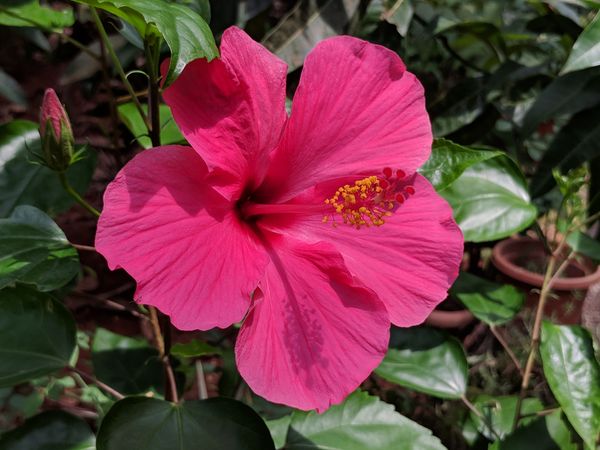Chinese Hibiscus Care Guide
How to grow and care for Chinese Hibiscus (Hibiscus rosa-sinensis)
The Hibiscus rosa-sinensis, commonly known as the Chinese Hibiscus, is a vivid and stunning flowering plant treasured for its lush, tropical blooms. A popular choice for indoor gardeners, this plant features glossy green leaves and produces large, trumpet-shaped flowers in a spectrum of colors, bringing a touch of the exotic to any home. With the right care and attention, your indoor hibiscus can bloom profusely and enhance your living space with its beauty.

Disclosure: This content includes affiliate links, which means we may earn a commission if you click on a link and make a purchase. As an Amazon Associate, we earn from qualifying purchases. This comes at no extra cost to you and helps offset the cost of running Leafwise. Please read our disclaimer for more info.
Table of Contents
Care
Light
Hibiscus plants require bright, indirect light to thrive. Insufficient light may reduce blooming, while too much direct sunlight can scorch the leaves. An east or south-facing window is ideal for indoor hibiscus plants.
Temperature and Humidity
Maintain temperatures between 65-85°F (18-29°C). Hibiscus plants thrive in high humidity levels, so regular misting, using a pebble tray, or placing a humidifier nearby can improve their growth.
Watering
Water your hibiscus thoroughly when the top inch of soil feels dry. Ensure proper drainage to prevent root rot. During warmer months, increase watering frequency, while in cooler months, reduce watering to prevent over-saturation. Always use room-temperature water to avoid shocking the roots.
Soil
A well-draining, slightly acidic potting mix (pH 6.0-6.5) is ideal. A combination of peat moss, perlite, and pine bark provides adequate aeration and drainage.
Fertilization
Feed the plant every two weeks during the growing season (spring and summer) with a high-potassium, water-soluble fertilizer to encourage blooming. Reduce fertilization in fall and winter when growth slows.
Maintenance
Pruning
Prune your hibiscus in early spring to maintain shape and encourage bushier growth. Cut back stems by up to one-third and remove any dead or weak branches.
Cleaning
Dust the leaves regularly with a damp cloth to enhance photosynthesis and reduce the risk of pests. Avoid using leaf shine products, as they can block leaf pores.
Repotting
Repot every 2-3 years or when the plant becomes root-bound. Select a slightly larger pot with fresh, well-draining soil to allow for continued healthy growth. Ensure the pot has drainage holes to prevent water accumulation.
Propagation
Hibiscus plants can be propagated using stem cuttings:
- Select a healthy, non-flowering stem (4-6 inches long) and cut just below a node.
- Remove lower leaves and dip the cut end in rooting hormone.
- Plant in a moist, well-draining soil mix and keep in bright, indirect light.
- Maintain humidity by covering with plastic or placing the pot in a greenhouse-like environment. Roots typically develop within 4-6 weeks.
Common Issues
Pests
Common pests: Aphids, spider mites, and whiteflies.
- Symptoms: Sticky residue, curling leaves, or webbing.
- Solution: Rinse with water, apply neem oil, or use insecticidal soap. Regularly inspect leaves for early signs of infestation.
Fungal Diseases
Cause: Poor airflow and excess moisture.
- Symptoms: Black spots, leaf discoloration, or wilting.
- Solution: Improve air circulation, reduce watering, and apply a fungicide if needed. Avoid splashing water on the leaves.
Yellowing Leaves
Cause: Overwatering, nutrient deficiency, or temperature stress.
- Symptoms: Leaves turning yellow and dropping prematurely.
- Solution: Adjust watering schedule, ensure proper fertilization, and avoid sudden temperature changes. If lower leaves yellow naturally, this may be part of the plant’s normal aging process.
By following these care guidelines, your Hibiscus rosa-sinensis will remain healthy and vibrant, producing stunning blooms throughout the growing season.
